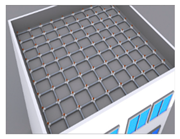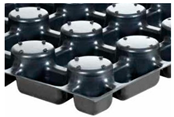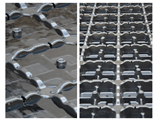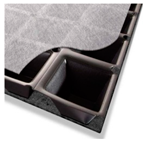Abstract
Climate change is a significant problem that many countries are currently facing, and green roofs (GRs) are one of the suitable choices to confront it and decrease its impacts. The advantages of GRs are numerous, such as stormwater management, thermal need reduction, runoff quality, and life quality improvement. However, there are some limitations, including the weight, limits in water retention, irrigation in the drought period, suitability of harvested water for building usages, installation on sloped roofs, and high cost. Therefore, developing a novel system and design for GRs with higher efficiency and fewer negative points seems necessary and is the main scope of this research. In this regard, a novel multipurpose self-irrigated green roof with an innovative drainage layer combined with specific multilayer filters has been developed. The application of the proposed system in terms of water retention capacity, water storage volume, runoff treatment performance, irrigation system, drainage layer, application of the harvested water for domestic purposes, and some other aspects has been analyzed and compared with the conventional systems with a focus on extensive green roofs. The results demonstrate that this novel green roof would have many advantages including less weight due to the replacement of the gravel drainage layer with a pipeline network for water storage, higher water retention capacity due to the specific design, higher impacts on runoff treatment due to the existence of multilayer filters that can be changed periodically, easier installation on flat and sloped roofs, the possibility of using the collected rainfall for domestic use, and fewer irrigation water demands due to the sub-surface self-irrigation system.
1. Introduction
The population percentage in cities is increasing significantly in developed countries, and is projected to increase by 83% in 2030. Therefore, related issues of urbanization and climate change have gained great importance [1]. Due to the predictions about the rapid growth of urbanization in many countries, environmental degradation is also expected to significantly increase [2,3]. To confront these issues and for sustainable urbanization, applications of nature-based solutions (NBSs) could be a suitable choice [4]. NBSs are strategies and planning opportunities that, if implemented, would result in a positive environmental impact, such as adaptation to climate change and increasing urban resilience to risks such as droughts, floods, and heatwaves [5].
One NBS to decrease some of the environmental and urbanization issues is using green stormwater infrastructure, such as green roofs, which can reduce the adverse effects of increasing urbanization [6,7,8]. Green roofs combine climate change mitigation and adaptation, biodiversity objectives, stormwater management, energy saving, etc. A green roof or living roof is a type of building roof composed of a waterproof membrane and growing media with vegetation on top of it [9]. Green roofs are also called cool roofs [10] or eco-roofs (due to ecological benefits) [3]. The main green roof layers include load-bearing components, insulation, waterproofing, drainage, filter, root barrier, substrate, and vegetation [11,12,13,14].
In general, green roofs are classified into three types based on the category of vegetation and soil layers, including extensive green roofs (EGR), which are normally created to perform an ecological function; semi-intensive green roofs (SIGR), which can have an amenity function; and intensive green roofs (IGR), which can be more broadly similar to roof gardens and are even used for urban agriculture [15,16].
The amount of water retention by green roofs depends on factors such as the intensity and volume of rainfall, the depth of the green roof, the roof slope, and the time that passed from the last rainfall event [17,18,19]. Previous studies showed the low efficiency of green roofs in runoff decay/delay in frequent rainfall events or severe storms [20,21]. The runoff treatment performance of green roofs depends on the substrate materials, plants, and application of fertilizer. Green roofs can decrease pollutant loads due to runoff reduction [22,23]. While green roofs can store nitrogen, zinc, and lead from rainfall, they can increase the amount of phosphorus in runoff due to the use of fertilizer [24]. In some cases, green roofs could negatively affect the runoff quality, which depends on the type of green roof, substrate, age of the green roof, maintenance, and local condition [25]. The results of the analysis by Liu et al. showed a significant increase in total phosphorus (TP) and total nitrogen (TN) in green roof runoff [26]. A similar analysis in Portland, Oregon, exhibited the same results for TP and TN but lower Zn concentrations compared to the conventional roofs [27]. The analysis determined that using materials such as iron-filing-based green environmental media (IFGEM) could decrease the runoff pollution concentration. The values for nitrate removal were over 90%, and for total phosphorus, up to 70% [28]. Another way to reduce the runoff pollution load could be using filters [25]. Moreover, from the water quality viewpoint, soil media with a low nutrient content (but enough for plant growth) could be more suitable for green roofs [29].
In terms of acceptance and social preference, green roofs with the lowest cost but highest aesthetic view are in demand [30]. The installation of green roofs in Germany increased from 1% in the late 19th century to around 10% of houses in 2006 [24,31]. In North America, the estimated overall green roof industry growth from 2013 to 2019 was about 5–15%, of which more than 80% were extensive green roofs and the vast majority were installed for commercial and industrial buildings [32].
Many studies have outlined the advantages of green roofs and the growth in their installation in recent years. However, there are some weaknesses in conventional green roofs, mainly due to issues such as the cost, high water demands in the summer, and high weight, which, if decreased, would incur a decrease in the water retention capacity. Considering these limitations and the rise in the number of houses with green roofs, improving the design of green roofs seems necessary. Therefore, this study aims to propose a new green roof system with a decreased weight, simple construction, improved water retention capacity, decreased water demands, and self-irrigation with higher impacts on runoff treatment.
2. Materials and Methods
The study analysis diagram is shown in Figure 1. As can be seen in the research analysis diagram, to be able to improve the conventional green roof systems, first, an in-depth literature analysis must be carried out. In this regard, the performance and efficiency of conventional green roofs have been analyzed, including the water retention capacity, water demands, runoff treatment, total weight, and installation and maintenance issues. Moreover, the design elements and specifications of different types of green roofs have been assessed, as have the main issues and advantages/disadvantages of conventional green roofs. In the next step, we proposed a novel self-irrigated green roof system with higher efficiency and fewer negative points in urban environments. Then, we explained how the novel system is supposed to solve the main issues with conventional green roofs.

Figure 1.
Research analysis diagram.
2.1. The Specifications of Different Types of Green Roofs
The specifications of different types of GRs are presented in Table 1.

Table 1.
Main specifications of green roofs.
2.2. Strengths and Weaknesses of Green Roofs
Green roofs provide a wide range of benefits, such as:
- Reducing urban runoff [44,45,46];
- Reducing the urban heat island effect [47];
- Increasing lifespan and durability of roofs [48];
- Decreasing roof temperature [49];
- Increasing buildings’ energy efficiency [50];
- Decreasing the water footprint of energy [51,52];
- Enhancing local biodiversity [3,53];
- Noise reduction [3,53];
- Improving local air quality [3];
- Psychological benefits [3].
The weaknesses of conventional green roofs include [20,21,54]:
- High evapotranspiration and water demand;
- The initial cost of green roofs is more expensive than traditional roofs;
- Requirement of an irrigation system in some cases;
- Increase in runoff pollution concentration for some parameters such as total phosphorus (TP) and total nitrogen (TN), especially in the case that soil media contains high nutrients;
- Increased roof load and additional maintenance requirements;
- Low efficiency in runoff decay/delay in frequent rainfall events or severe storms [20,21];
- Restrictions in the choice of plants due to the harsh climate (low precipitation, high solar radiation, etc.) [24].
2.3. The Irrigation Systems of Green Roofs and Advantages of Sub-Surface Irrigation
In green roofs, the irrigation system depends on the climate and type of green roof [55,56], and the thermal impacts depend on the irrigation, especially in the summer [49,57], as well as the substrate material, depth, and vegetation [58]. In the Mediterranean climate, the daily water demand for the irrigation of an extensive green roof in summer is between 2.6 and 9.0 L/m2 [59], more specifically 7 L/m2 in Rende (Italy) [60], around 2 L/m2 in Athens (Greece) [61], and 4.5–7.0 L/m2 in Tel Aviv (Israel) [59]. The results of another study for a humid–subtropical climate in Hong Kong (China) show daily summer water demands of about 5 L/m2 [62]. The daily summer water demands for a temperate oceanic climate in Neubrandenburg (Germany) were 3–5 L/m2 [63].
The irrigation systems of green roofs are usually sprinkler-based or drip irrigation systems. However, sub-surface irrigation could be an appropriate method for decreasing the water requirement of green roofs. Sub-surface irrigation decreases water consumption by decreasing evaporation [64], and in windy conditions, the performance is better than sprinkler-based irrigation. Moreover, sub-surface irrigation uses less water than drip irrigation as the water directly reaches the roots [65]. Other water-saving irrigation technologies include subsurface drip irrigation, subsurface irrigation with ceramic emitters (SICE) [66,67], and surge-root irrigation [68]. Sub-surface irrigation is based on the capillary, and the maximum height of the capillary rise depends on factors including the specific gravity, dry density, hydraulic conductivity, contact angle, etc. [69]. The average height of the capillary rises of some soils is as follows: coarse sand: 15 cm, fine sand: 50 cm, coarse silt: 300 cm, and fine silt: 750 cm [70]. In this regard, in this study, a novel multilayer filter is proposed for runoff management (decay and delay) and sub-surface irrigation.
3. Results and Discussion
3.1. A Novel Multipurpose Self-Irrigated Green Roof with an Innovative Drainage Layer
The details of the proposed multipurpose self-irrigated green roof with an innovative drainage layer are presented in Figure 2, Figure 3, Figure 4, Figure 5, Figure 6 and Figure 7. The details of the novel green roof layers are shown in Figure 8 and Figure 9.
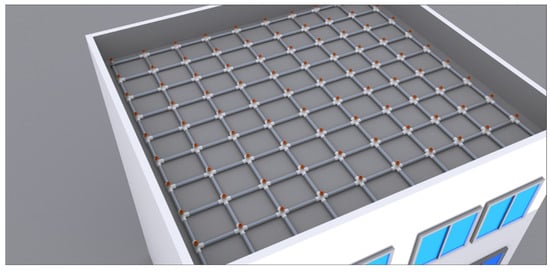
Figure 2.
PVC pipeline network for water storage and self-irrigation.
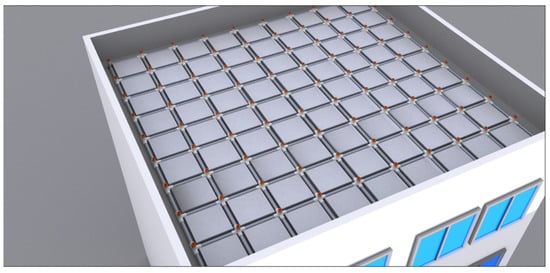
Figure 3.
Filling the empty area between PVS tubes with polystyrene foam, expanded clay aggregate, or similar local lightweight aggregate (the same diameter as PVC pipe).
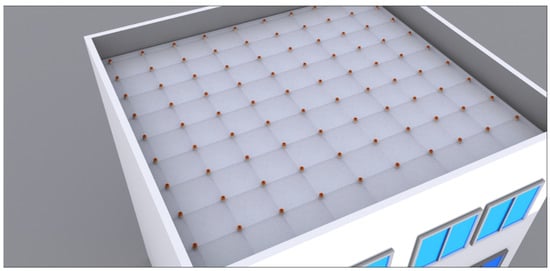
Figure 4.
A 1 cm layer of polystyrene foam used to create a smooth surface for the upper layers.
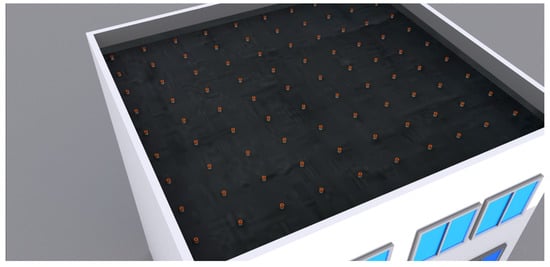
Figure 5.
Waterproofing membrane layer.
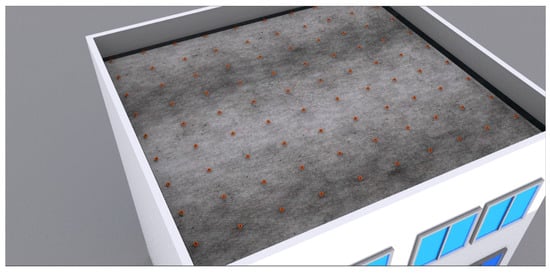
Figure 6.
Root barrier or anti-root layer (on the top of the waterproofing membrane layer).
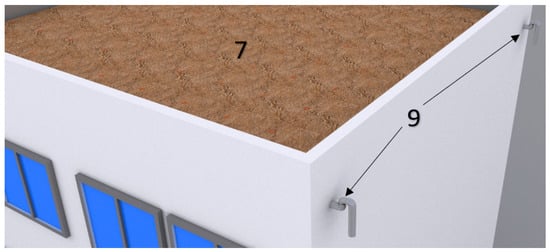
Figure 7.
Soil media on the top of the root barrier layer (8 cm or more, depending on the plants). (7) soil media; (9) exit upside-down U-shaped tube.
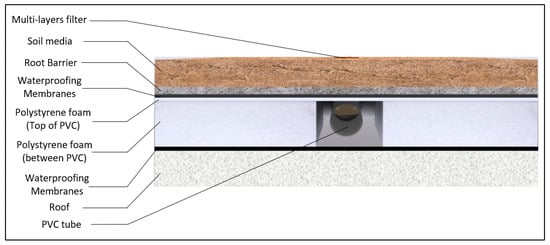
Figure 8.
The layers in the novel green roof.
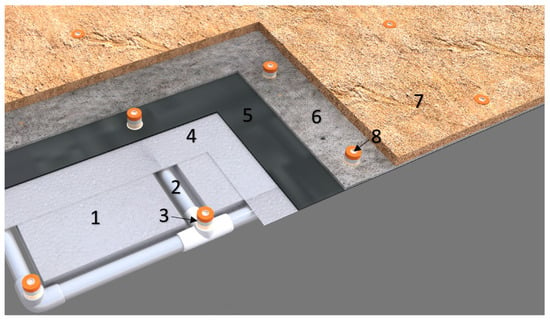
Figure 9.
Details of all layers. (1) Polystyrene foam; (2) PVC tube; (3) multilayer filter; (4) 1 cm of polystyrene foam; (5) waterproofing membrane; (6) root barrier layer; (7) soil media; (8) drain filters.
Figure 10 shows the pipeline network and upside-down U-shaped tube for the withdrawal of extra water. With this design, the water will fill and remain in the pipeline network as water storage to be used for irrigation or other non-potable water uses of the building. If necessary (e.g., for cleaning, maintenance, or before a severe flood), it would be possible to empty the pipeline network. The network dimension would depend on the roof’s flatness; an uneven roof can be divided into several separate pipeline networks instead of one. Moreover, the system can be easily installed on a sloped roof, as shown in Figure 11.

Figure 10.
Details of the exit upside-down U-shaped tube for the withdrawal of extra water, and inlet for refilling it. (3) multilayer filters; (2) pipeline network; (9) exit upside-down U-shaped tube; (10) inlet.

Figure 11.
Details of the pipeline network on a sloped roof.
Figure 12 presents more details of the novel multipurpose self-irrigating GRs.
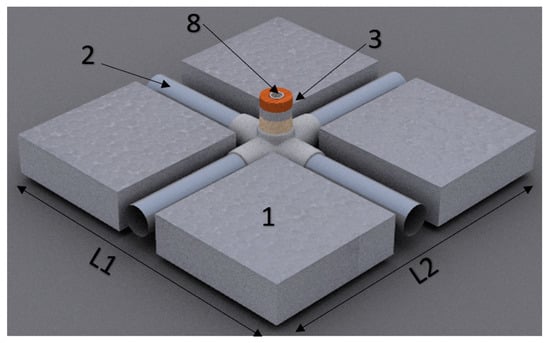
Figure 12.
More details of the novel multipurpose self-irrigated GRs. (1) Polystyrene foam or other low-weight materials (the same diameter of PVC pipe); (2) PVC (75 mm, 90 mm, 100 mm, or 110 mm); (3) multilayer filter (the same diameter as the pipe and the exact height of the total green roof dimension); (8) drain filters; L1 and L2 indicate the width for installation of a filter that depends on the soil media and required filter for sub-irrigation.
Figure 13 exhibits installation details of the waterproofing membrane layer that needs to be installed at the same level as the multilayer filter entrance. Therefore, the water can be drained by the multilayer ceramic/soil/polypropylene filter.
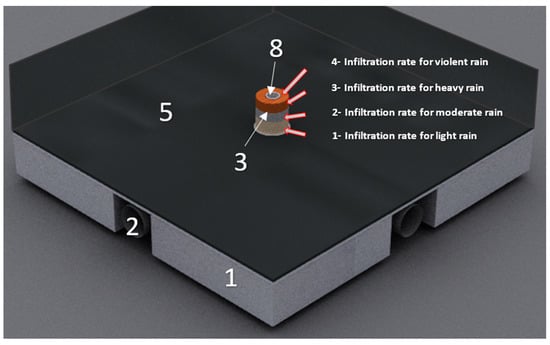
Figure 13.
Waterproofing membrane layer and details of the multilayer filter. Note: the total height after this layer needs to be equal to the entrance level of the filters so that the filters can drain the water and will not remain on the surface of this layer. (1) Polystyrene foam or other low-weight materials (the same diameter of PVC pipe); (2) PVC (75 mm, 90 mm, 100 mm, or 110 mm); (3) multilayer filter (the same diameter as the pipe and the exact height of the total green roof dimension); (5) waterproofing membrane; (8) drain filters.
The installation details of each layer of the multilayer filter, each with a specific property (infiltration rate), are shown in Figure 14. The filter will be used for sub-surface irrigation based on the capillary rise in water in the filters, similar to the SICE irrigation method explained in Section 2.1.
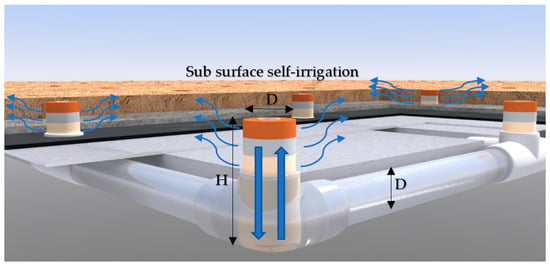
Figure 14.
The multilayer filter: each layer has a different infiltration rate. The diameter (D) is equal to the internal diameter of the PVC tube, and the height (H) is equal to the total height of the green roof (from the roof surface to the top of the soil layer).
The schematic of the multilayer filter for drainage and sub-surface irrigation is presented in Figure 15. As can be seen, the multilayer filter can be made from ceramic, soil layers, or polypropylene with different cartridge sizes.

Figure 15.
The schematic of the multilayer filter for drainage and sub-surface irrigation.
3.2. How the Novel System Works
As shown in Figure 2, Figure 3, Figure 4, Figure 5, Figure 6, Figure 7, Figure 8, Figure 9, Figure 10, Figure 11, Figure 12, Figure 13, Figure 14 and Figure 15, the novel green roof system combined with a specific drainage system and multilayer filter to benefit from a subsurface irrigation system has the same aesthetic appearance, increases the advantages of green roofs, and decreases their negative impacts. In the next paragraphs, it will be explained how the system works by referring to the number of each part/object in the figures.
The green roof system can be installed on building roofs and is made up of soil media that can be planted (7), linked by multilayer filters (3) to the pipeline network with required diameter that can stores water (2). It is also including waterproof membrane (5), and root barrier layer (6) installs on the top of the waterproof membrane. Preferably but not exclusively the lightweight materials (1) such as Polystyrene foam, expanded clay aggregate, or similar lightweight aggregate can be used to fill the empty spaces among the pipeline network (2), that the height is equal to the diameter of the pipeline network (D). On the top of pipeline network (2) and the lightweight materials (1) among the network, another layer exists (4) that can be from the same lightweight or other materials, but only one or few centimeters. The role of this layer is to create a flat and horizontal surface for installation of waterproof membrane on the top of it.
The multilayer filter (3) are hollow cylinders with several layers preferably but not exclusively from ceramic, soil, or polypropylene to filter the drainage water and are with the same diameter (D) of the pipeline network (2), and the exact height of the total green roof platform (H). The installation level of the waterproofing membrane layer (5) needs to be at the same level with the entrances of the multilayer filters (3); therefore, the water on the green roof and soil from precipitations can be drained by different filters. In the multilayer filters (3), each layer’s properties (material) would be based on the required infiltration rate and rainfall intensity. It means the lowest layer (layer 1 in Figure 13) would be from fine materials, so the infiltration rate is lowest, and it is suitable for light rainfall, and at the same time, the capacity in runoff treatment is highest. By increasing the rainfall intensity, the water level on top of the waterproof membrane (5) would increase and arrive at the second layer of multilayer filters (layer 2 in Figure 13). This layer is a filter with a higher water infiltration rate than layer 1, thus, would be suitable for drainage of the rains with moderate intensity. The same mechanism exists for the third layer (layer 3 in Figure 13), which are suitable for heavy rainfalls. Finally, in the case of extensive rainfall that exceeds the drainage capacity of the layers, direct water exit can be ensured from the drain filters (8), which are placed at the upper middle of the hollow cylinders of the multilayer filter (3).
The innovative multilayer filter (3) has several purposes, mainly runoff drainage, runoff treatment, and sub-surface irrigation. The required drainage depends on the rainfall intensity, the required water treatment depends on the runoff quality, and the sub-irrigation is based on the required water demands and soil media type (7). Therefore, L1 and L2, which are the dimensions for the installation of one multilayer filter that can be used not only for drainage and treatment but also sub-irrigation through capillary action, can be selected according to the design. In this regard, the layers and number of multilayer filters (3) can be optimized according to the aforementioned requirements.
The water storage in the novel green roof is substantiated by a pipeline network (2) that, once full, can expel excess water using an upside-down U-shaped tube (9). Moreover, the collected water inside the pipeline network (2) can be easily linked to the buildings and used for non-potable domestic demands. The irrigation mechanism in the novel system as shown in Figure 14 is sub-surface self-irrigation by a multilayer filter (3), which is connected to the pipeline network (2). Moreover, in periods without rainfall, and when the pipeline networks are empty, the pipeline network (2) can be refilled directly by an intel pipe (10); thus, sub-surface irrigation can be performed easily.
3.3. The Main Elements in the Novel Multipurpose Self-Irrigated Green Roof with an Innovative Drainage Layer
The main features of the novel multipurpose self-irrigated green roof are as follows:
- Green roof platform, height = PVC diameter + waterproofing membrane + root barrier layer + soil media;
- Collectors: PVC (75 mm, 90 mm, 100 mm, or 110 mm) can be used for water storage and sub-surface irrigation;
- Multilayer filter: for drainage of different rainfall intensities and sub-surface irrigation. The height would be equal to the total green roof height;
- Waterproofing membrane 0.5–1 cm;
- Root barrier layer: 0.5–1 cm;
- Soil media: around 8 cm for an extensive green roof and more for intensive green roof;
- Polystyrene foam or expanded clay aggregate (or similar local lightweight aggregate) for filling the void area among pipelines. The diameter is equal to the PVC pipeline diameter;
- Exit pipe: upside down U-shaped tube to expel extra water after the PVC pipelines on the roof are full;
- Drain filter: install on the top of the multilayer filter, which is a hollow cylinder;
- Inlet pipe: for filling the pipeline network for sub-surface irrigation;
- L1 and L2: the width for installation of a filter that depends on the soil media and the required filter for sub-irrigation;
- Plants: depends on the type of green roof;
- Water storage for harvesting extra water for sub-surface irrigation or non-potable domestic water usage.
3.4. The Main Possible Applications of the Novel System
The main applications of the novel system are as follows:
- An alternative to conventional green roofs on buildings;
- For sub-surface irrigation;
- For urban runoff water treatment;
- To decrease the weight of conventional green roofs;
- To decrease the water demands of conventional green roofs, especially in the summer;
- For harvesting water for non-potable water usage of the buildings;
- To improve the efficiency of conventional green roofs;
- To improve the thermal impact of buildings;
- Can be installed on a sloped roof and therefore has higher application potential compared to conventional green roofs.
3.5. Performance Analysis of the Novel Multipurpose Self-Irrigated Green Roof
The details and performance of the novel system for three sizes of PVC tubes as the water storage layer and in the case that a multilayer filter is installed for each 1 m2 area are presented in Table 2.

Table 2.
Details and water storage capacity of the novel system for three sizes of PVC tube.
The technical analysis shows the feasibility and advantages of using a pipeline network for drainage and the collection of rainfall, a filter for runoff treatment, and a sub-surface irrigation system to decrease water usage.
The comparisons among water storage capacity in the novel proposed systems and conventional ones are presented in Table 3.

Table 3.
Water storage capacity of the novel system and conventional drainage layer systems.
3.6. The Advantages of the Novel Multipurpose Self-Irrigated Green Roof with Conventional Green Roofs
In this part, the main advantages of the novel green roof system with conventional green roofs have been presented. Although the proposed system (specific drainage, filtration, and irrigation system based on multilayer filters) can be applied to all types of green roof, the focus in this study is extensive green roofs as they are more commonly installed [24,47,55].
- In conventional green roofs, the efficiency in terms of runoff pollution control, frequent rainfall management, and water demands for irrigation is low. However, such aspects are significantly improved in the new green roof system by the use of a pipeline network instead of a drainage layer combined with specific multilayer filters that can be used for several purposes for infiltration, treatment, and irrigation. The new system could improve the water retention capacity and application of conventional systems. Moreover, the innovative design could decrease the weight, increase the water storage, and improve the harvested rainwater quality;
- In some conventional green roofs, the drainage layer is composed of gravel or granular materials. However, the specific weight of gravel is nearly double that of water, and the water storage capacity of granular materials is not very high. Both of these issues have been solved in the new system by using a pipeline network as the drainage layer. In this system, water storage can be increased easily by using a tube with a greater diameter. Moreover, for storing water, there is no need to add gravel or other high-weight porous media layers;
- In some of the conventional green roofs, the drainage layers are drainage boards/geofabrics, which are not readily easily in different sizes, making construction difficult. However, in the novel design, different sizes of tubes are easily available, making the construction easy with a pre-planned water storage capacity;
- In conventional green roofs, the flood management efficiency during frequent rainfall events is low as the stored water in the drainage layer cannot be emptied before a severe flood. This issue is solved in the novel system. In fact, in the new system, the stored water in the pipeline network can be emptied easily before a severe rainfall event, making the system ready for an upcoming flood;
- The collected runoff in the drainage layer of conventional green roofs cannot be used for purposes other than irrigation, whereas in the new proposed system, the water is stored in the pipeline network and is purified by the multilayer filter; thus the water can be easily linked to the buildings and used for non-potable domestic demands such as toilet cisterns, etc.;
- In conventional green roofs, the retained water by the storage layer is only partially available to the plant, and the water stored for planting by capillary action is not in direct contact with the growing media. Therefore, to meet the plants’ water requirements, the depth of the growing medium layer should be increased, increasing the load on the structure and increasing the roof weight [54]. However, in the new system, the specific multilayer filters with varied specifications (flow rate and purification capacity) link the upper and lower layers through infiltration and capillarity. Multilayer filters can be designed based on the rainfall intensity and required infiltration rate, improving the system’s flood management aspect. Moreover, they can be optimized based on the urban water contamination load to improve the water quality in the urban drainage network;
- In conventional green roofs, the irrigation system in the summer (or in a dry period in which the drainage layer is empty) is usually a sprinkler-based or drip irrigation system, which both have a high evaporation rate. However, the irrigation mechanism in the novel system is sub-surface self-irrigation, which is a suitable method for decreasing the water requirement of green roofs as the water directly reaches the roots, so the water consumption is lower than in drip irrigation systems. In periods without rainfall and when the pipeline networks are empty, sub-surface irrigation can be performed easily by directly refilling the pipeline network.
3.7. Recommendation for Future Works
Simulations of the new drainage system with HYDRUS-2D to optimize the number of filters for drainage and sub-surface irrigation are suggested for future studies. Moreover, the performance of the new proposed green roof in runoff treatment can be assessed by field tests in different municipalities, especially those with air pollution, which is recommended for future works.
4. Conclusions
Climate change is a significant problem that many countries are currently facing, and green roofs are one method to confront it and decrease its impacts. Several studies have analyzed the application, properties, and benefits of green roofs in urban environments; highlighted the flood management and runoff water treatment capacities; and outlined the thermal, environmental, and social benefits. The efficiency and feasibility of green roofs depend on parameters including the weight, water retention capacity, installation on sloped roofs, irrigation during drought periods, and water requirements for irrigation; all of these need to be improved to increase the application potential of green roofs. Therefore, developing a new system with higher efficiency and fewer negative points seems necessary.
We proposed a multipurpose self-irrigated green roof with an innovative drainage layer combined with specific multilayer filters. The new system could improve the water retention capacity due to a higher storage volume that is based on a pipeline network and can be increased easily by increasing the pipeline diameter. In addition, the flood management efficiency of the novel green roof in frequent rainfall events is higher as the drainage layer in the conventional green roofs cannot be emptied before severe rainfall, whereas in the new proposed system, the stored water in the pipeline network can be emptied easily before a severe rainfall event, making the system ready for an upcoming influx in rainfall. The multilayer filters (from different layers of ceramic/soil/polypropylene/etc.), in which each layer has a different infiltration rate and water treatment capacity, allows easier stormwater management, and the harvested rainwater has higher quality due to the filtration system. In fact, the pollutant loads carried out by urban runoff can be significantly reduced through the presented innovative drainage layer, and the runoff treatment performance can be maximized as the filters can be periodically changed. Moreover, the harvested rainfall, which is treated by the filters, will be stored in the pipeline network and can thus be easily linked to buildings and used not only for irrigation but also for non-potable demands such as toilet cisterns, etc. Additionally, for irrigation in the summer, and in the case that the pipeline network is empty, it can be refilled directly from the water network, and multilayer filters will sub-irrigate the soil by capillarity action.
In conclusion, the novel green roof has plenty of advantages: less weight due to replacement of the gravel drainage layer by a pipeline network for water storage, higher water retention capacity due to the specific design of the drainage layer, higher impacts on runoff treatment due to the existence of multilayer filters that can be changed periodically, easy application of the collected rainfall, fewer water demands in the summer due to the sub-surface self-irrigation system, and a more natural self-irrigation mechanism as the system uses a sub-irrigation technique based on the capillary rise.
Author Contributions
Conceptualization, B.P., H.J.N., and S.A.P.; methodology, B.P., S.A.P., H.J.N., and M.T.; formal analysis, B.P., H.J.N., and S.A.P.; investigation, B.P., H.J.N., and S.A.P.; data curation, B.P.; writing—original draft preparation, B.P., H.J.N., M.T., and S.A.P.; writing—review and editing, B.P., S.A.P., H.J.N., and M.T.; visualization, B.P., H.J.N., and M.T.; supervision, G.B., U.S., and P.P. All authors have read and agreed to the published version of the manuscript.
Funding
The author S.A.P. is supported by the Italian Ministry of University and Research (D.M. n. 1062/2021)—REACT EU—National Operational Program on Research and Innovation (PON R&I) 2014–2020—Axis IV; Action IV.4, Action IV.6. CUP: H25F21001230004. IC: 1062_R18_GREEN.
Data Availability Statement
Not applicable.
Acknowledgments
We acknowledge the research project “TOP FREE—Tetti e Orti Pensili a “Filiera corta” per la Riqualificazione di Edifici Esistenti”—POR CALABRIA FESR-FSE 2014-2020—Action 1.1.5- CUP J29J21001760005.
Conflicts of Interest
The authors declare no conflict of interest.
References
- Antrop, M. Landscape change and the urbanization process in Europe. Landsc. Urban Plan 2004, 67, 9–26. [Google Scholar] [CrossRef]
- Ewing, L. Coastal megacities and hazards: Challenges and opportunities. Shore Beach 2008, 76, 36–40. [Google Scholar]
- Shafique, M.; Kim, R.; Rafiq, M. Green roof benefits, opportunities and challenges—A review. Renew. Sustain. Energy Rev 2018, 90, 757–773. [Google Scholar] [CrossRef]
- Oral, H.V.; Radinja, M.; Rizzo, A.; Kearney, K.; Andersen, T.R.; Krzeminski, P.; Buttiglieri, G.; Ayral-Cinar, D.; Comas, J.; Gajewska, M.; et al. Management of urban waters with nature-based solutions in circular cities—Exemplified through seven urban circularity challenges. Water 2021, 13, 3334. [Google Scholar] [CrossRef]
- European Commission Nature-Based Solutions & Re-Naturing Cities; EU Publications: Brussels, Belgium, 2015; Volume 35, ISBN 9789279460517.
- Keeley, M. The green area ratio: An urban site sustainability metric. J. Environ. Plan. Manag. 2011, 54, 937–958. [Google Scholar] [CrossRef]
- Carbone, M.; Turco, M.; Nigro, G.; Piro, P. Modeling of hydraulic behaviour of green roof in catchment scale. In Proceedings of the International Multidisciplinary Scientific GeoConference Surveying Geology and Mining Ecology Management, SGEM, Albena, Bulgaria, 17–26 June 2014; Volume 1, pp. 471–477. [Google Scholar]
- Carbone, M.; Turco, M.; Brunetti, G.; Piro, P. A Cumulative Rainfall Function for Subhourly Design Storm in Mediterranean Urban Areas. Adv. Meteorol. 2015, 2015, 1–10. [Google Scholar] [CrossRef]
- Droguett, B.R. Sustainability Assessment of Green Infrastructure Practices for Stormwater Management: A Comparative Emergy Analysis; University of New York, College of Environmental Science and Forestry, ProQuest Dissertations Publishing: New York, NY, USA, 2011; p. 29057205. Available online: https://www.proquest.com/docview/900864997?pq-origsite=gscholar&fromopenview=true (accessed on 28 December 2022).
- Xu, T.; Sathaye, J.; Akbari, H.; Garg, V.; Tetali, S. Quantifying the direct benefits of cool roofs in an urban setting: Reduced cooling energy use and lowered greenhouse gas emissions. Build. Environ. 2012, 48, 1–6. [Google Scholar] [CrossRef]
- Bozorg Chenani, S.; Lehvävirta, S.; Häkkinen, T. Life cycle assessment of layers of green roofs. J. Clean. Prod. 2015, 90, 153–162. [Google Scholar] [CrossRef]
- Cipolla, S.S.; Maglionico, M.; Stojkov, I. A long-term hydrological modelling of an extensive green roof by means of SWMM. Ecol. Eng. 2016, 95, 876–887. [Google Scholar] [CrossRef]
- Catalano, C.; Laudicina, V.A.; Badalucco, L.; Guarino, R. Some European green roof norms and guidelines through the lens of biodiversity: Do ecoregions and plant traits also matter? Ecol. Eng. 2018, 115, 15–26. [Google Scholar] [CrossRef]
- Brunetti, G.; Turco, M.; Carbone, M.; Maiolo, M.; Piro, P. Modelling the hydraulic behaviour of green roofs through a semi-conceptual reservoir element model. In Proceedings of the International Multidisciplinary Scientific GeoConference Surveying Geology and Mining Ecology Management, SGEM, Albena, Bulgaria, 2–8 July 2018; Volume 18, pp. 499–506. [Google Scholar] [CrossRef]
- Hossain, M.A.; Shams, S.; Amin, M.; Reza, M.S.; Chowdhury, T.U. Perception and barriers to implementation of intensive and extensive green roofs in Dhaka, Bangladesh. Buildings 2019, 9, 79. [Google Scholar] [CrossRef]
- Rocha, B.; Paço, T.A.; Luz, A.C.; Palha, P.; Milliken, S.; Kotzen, B.; Branquinho, C.; Pinho, P.; de Carvalho, R.C. Are biocrusts and xerophytic vegetation a viable green roof typology in a mediterranean climate? A comparison between differently vegetated green roofs in water runoff and water quality. Water 2021, 13, 94. [Google Scholar] [CrossRef]
- Lee, J.Y.; Lee, M.J.; Han, M. A pilot study to evaluate runoff quantity from green roofs. J. Environ. Manag. 2015, 152, 171–176. [Google Scholar] [CrossRef]
- Getter, K.L.; Rowe, D.B.; Andresen, J.A. Quantifying the effect of slope on extensive green roof stormwater retention. Ecol. Eng 2007, 31, 225–231. [Google Scholar] [CrossRef]
- Vijayaraghavan, K.; Raja, F.D. Design and development of green roof substrate toimprove runoff water quality: Plant growth experiments and adsorption. Water Res. 2014, 63, 94–101. [Google Scholar] [CrossRef] [PubMed]
- Moran, A.; Hunt, B.; Jennings, G. A North Carolina Field Study to Evaluate Greenroof Runoff Quantity, Runoff Quality, and Plant Growth. In Proceedings of the World Water and Environmental Resources Congress, Philadelphia, PA, USA, 23–26 June 2003. [Google Scholar] [CrossRef]
- Connelly, M.; Liu, K. 3.2: New Directions in Green Roof research—Green roof research in British Columbia—An overview. In Proceedings of the Greening rooftops for sustainable communities, Washington, DC, USA, 4–6 May 2005; Available online: https://commons.bcit.ca/greenroof/files/2012/01/3.2_connelly_lui.pdf (accessed on 28 December 2022).
- Gregoire, B.G.; Clausen, J.C. Effect of a modular extensive green roof on stormwater runoff and water quality. Ecol. Eng. 2011, 37, 963–969. [Google Scholar] [CrossRef]
- Palermo, S.A.; Zischg, J.; Sitzenfrei, R.; Rauch, W.; Piro, P. Parameter Sensitivity of a Microscale Hydrodynamic Model. In Proceedings of the International Conference on Urban Drainage Modelling (UDM 2018), Palermo, Italy, 23–26 September 2018; Springer: Cham, Switzerland, 2018. [Google Scholar] [CrossRef]
- Li, W.C.; Yeung, K.K.A. A comprehensive study of green roof performance from environmental perspective. Int. J. Sustain. Built Environ. 2014, 3, 127–134. [Google Scholar] [CrossRef]
- Berndtsson, J.C.; Emilsson, T.; Bengtsson, L. The influence of extensive vegetated roofs on runoff water quality. Sci. Total Environ. 2006, 355, 48–63. [Google Scholar] [CrossRef]
- Liu, W.; Wei, W.; Chen, W.; Deo, R.C.; Si, J.; Xi, H.; Li, B.; Feng, Q. The impacts of substrate and vegetation on stormwater runoff quality from extensive green roofs. J. Hydrol. 2019, 576, 575–582. [Google Scholar] [CrossRef]
- Okita, J.; Poor, C.; Kleiss, J.M.; Eckmann, T. Effect of green roof age on runoff water quality in Portland, Oregon. J. Green Build. 2018, 13, 42–54. [Google Scholar] [CrossRef]
- Wen, D.; Chang, N.-B.; Wanielista, M.P. Assessing Nutrient Removal in Stormwater Runoff for Urban Farming with Iron filings-based Green Environmental Media. Sci. Rep. 2020, 10, 1–13. [Google Scholar] [CrossRef] [PubMed]
- Hathaway, A.M.; Hunt, W.F.; Jennings, G.D. A field study of green roof hydrologic and water quality performance. Trans. ASABE 2008, 51, 37–44. [Google Scholar] [CrossRef]
- Joshi, M.Y.; Teller, J. Urban integration of green roofs: Current challenges and perspectives. Sustainability 2021, 13, 12378. [Google Scholar] [CrossRef]
- Köhler, M. Long-term Vegetation Research on Two Extensive Green Roofs in Berlin. Urban Habitats 2006, 4, 3–26. [Google Scholar]
- Green Roofs for Healthy Cities 2019—Annual Green Roof Industry Survey. Available online: https://cdn2.hubspot.net/hubfs/4115293/GreenRoofIndustrySurvey2019Report.pdf (accessed on 28 December 2022).
- SIG Design & Technology. Green Roof Systems—Bauder. Available online: https://www.singleply.co.uk/wp-content/uploads/2017/01/2017-Green-Roof-systems-overview.pdf (accessed on 28 December 2022).
- Palermo, S.A.; Turco, M.; Principato, F.; Piro, P. Hydrological effectiveness of an extensive green roof in Mediterranean climate. Water 2019, 11, 1378. [Google Scholar] [CrossRef]
- Zhang, Z.; Szota, C.; Fletcher, T.D.; Williams, N.S.G.; Farrell, C. Green roof storage capacity can be more important than evapotranspiration for retention performance. J. Environ. Manag. 2019, 232, 404–412. [Google Scholar] [CrossRef] [PubMed]
- Karachaliou, P.; Santamouris, M.; Pangalou, H. Experimental and numerical analysis of the energy performance of a large scale intensive green roof system installed on an office building in Athens. Energy Build. 2016, 114, 256–264. [Google Scholar] [CrossRef]
- Conservation Technology Inc. Green Roof Handbook. Available online: http://www.conservationtechnology.com/documents/GreenroofHandbook0116.pdf (accessed on 27 December 2022).
- Yu, W.D.; Cheng, S.T.; Miao, C.M.; Perng, G.Y. Green innovation of green roof technology—A case study: Umweltverträgliche Dachtechnologie—Eine Fallstudie. Materwiss. Werksttech. 2017, 48, 420–429. [Google Scholar] [CrossRef]
- Grunwald, L.; Heusinger, J.; Weber, S. A GIS-based mapping methodology of urban green roof ecosystem services applied to a Central European city. Urban For. Urban Green 2017, 22, 54–63. [Google Scholar] [CrossRef]
- Raji, B.; Tenpierik, M.J.; Van Den Dobbelsteen, A. The impact of greening systems on building energy performance: A literature review. Renew. Sustain. Energy Rev. 2015, 45, 610–623. [Google Scholar] [CrossRef]
- Breuning, J. Green Roof Technology. History. Available online: https://columbia-green.com/wp-content/uploads/2015/12/CGT-Green-Roof-Weights.pdf (accessed on 29 December 2022).
- Shafique, M.; Kim, R.; Kyung-Ho, K. Green roof for stormwater management in a highly urbanized area: The case of Seoul, Korea. Sustainability 2018, 10, 584. [Google Scholar] [CrossRef]
- Loiola, C.; Mary, W.; Pimentel da Silva, L. Hydrological performance of modular-tray green roof systems for increasing the resilience of mega-cities to climate change. J. Hydrol. 2019, 573, 1057–1066. [Google Scholar] [CrossRef]
- Turco, M.; Brunetti, G.; Carbone, M.; Piro, P. Modelling the hydraulic behaviour of permeable pavements through a reservoir element model. In Proceedings of the International Multidisciplinary Scientific GeoConference Surveying Geology and Mining Ecology Management, SGEM, Albena, Bulgaria, 2–8 July 2018; Volume 18, pp. 507–514. [Google Scholar] [CrossRef]
- Maiolo, M.; Palermo, S.A.; Brusco, A.C.; Pirouz, B.; Turco, M.; Vinci, A.; Spezzano, G.; Piro, P. On the use of a real-time control approach for urban stormwater management. Water 2020, 12, 2842. [Google Scholar] [CrossRef]
- Park, S.Y.; Oh, D.K.; Lee, S.Y.; Yeum, K.J.; Yoon, Y.H.; Ju, J.H. Combined Effects of Substrate Depth and Vegetation of Green Roofs on Runoff and Phytoremediation under Heavy Rain. Water 2022, 14, 2792. [Google Scholar] [CrossRef]
- Coma, J.; Pérez, G.; Solé, C.; Castell, A.; Cabeza, L.F. Thermal assessment of extensive green roofs as passive tool for energy savings in buildings. Renew. Energy 2016, 85, 1106–1115. [Google Scholar] [CrossRef]
- Gu, W.; Wei, L.; Zhang, W.; Yan, X. Evolutionary game analysis of cooperation between natural resource- and energy-intensive companies in reverse logistics operations. Int. J. Prod. Econ. 2019, 218, 159–169. [Google Scholar] [CrossRef]
- Maiolo, M.; Pirouz, B.; Bruno, R.; Palermo, S.A.; Arcuri, N.; Piro, P. The role of the extensive green roofs on decreasing building energy consumption in the mediterranean climate. Sustainability 2020, 12, 359. [Google Scholar] [CrossRef]
- Guattari, C.; Evangelisti, L.; Asdrubali, F.; De Lieto Vollaro, R.L. Experimental evaluation and numerical simulation of the thermal performance of a green roof. Appl. Sci. 2020, 10, 1767. [Google Scholar] [CrossRef]
- Pirouz, B.; Palermo, S.A.; Maiolo, M.; Arcuri, N.; Piro, P. Decreasing Water Footprint of Electricity and Heat by Extensive Green Roofs: Case of Southern Italy. Sustainability 2020, 12, 10178. [Google Scholar] [CrossRef]
- Pirouz, B.; Maiolo, M. The role of power consumption and type of air conditioner in direct and indirect water consumption. J. Sustain. Dev. Energy Water Environ. Syst. 2018, 6, 665–673. [Google Scholar] [CrossRef]
- Patnaik, B.; Seshadri, S.; Mathewos, E.; Gebreyesus, T. Impact of Green Roofs on Urban Living. Int. J. Curr. Eng. Technol. 2018, 8, 1656–1659. [Google Scholar]
- Nophadrain BV Exrensive Green Roofs, Design and Installation Manual. Available online: https://www.nophadrain.hr/media/231169/03_en_design-and-installation-guide_nophadrain-intensive-green-roof-system-02-2020_web.pdf. (accessed on 29 December 2022).
- Cascone, S. Green roof design: State of the art on technology and materials. Sustainability 2019, 11, 3020. [Google Scholar] [CrossRef]
- Pirouz, B.; Palermo, S.A.; Turco, M. Improving the efficiency of green roofs using atmospheric water harvesting systems (An innovative design). Water 2021, 13, 546. [Google Scholar] [CrossRef]
- Azeñas, V.; Cuxart, J.; Picos, R.; Medrano, H.; Simó, G.; López-Grifol, A.; Gulías, J. Thermal regulation capacity of a green roof system in the mediterranean region: The effects of vegetation and irrigation level. Energy Build. 2018, 164, 226–238. [Google Scholar] [CrossRef]
- Tan, K.; Wang, J. Substrate modified with biochar improves the hydrothermal properties of green roofs. Environ. Res. 2023, 216, 114405. [Google Scholar] [CrossRef] [PubMed]
- Schweitzer, O.; Erell, E. Evaluation of the energy performance and irrigation requirements of extensive green roofs in a water-scarce Mediterranean climate. Energy Build. 2014, 68, 25–32. [Google Scholar] [CrossRef]
- Brunetti, G.; Porti, M.; Piro, P. Multi-level numerical and statistical analysis of the hygrothermal behavior of a non-vegetated green roof in a mediterranean climate. Appl. Energy 2018, 221, 204–219. [Google Scholar] [CrossRef]
- Papafotiou, M.; Pergialioti, N.; Tassoula, L.; Massas, I.; Kargas, G. Growth of native aromatic xerophytes in an extensive Mediterranean green roof as affected by substrate type and depth and irrigation frequency. HortScience 2013, 48, 1327–1333. [Google Scholar] [CrossRef]
- Peng, L.L.H.; Jim, C.Y. Seasonal and diurnal thermal performance of a subtropical extensive green roof: The impacts of background weather parameters. Sustainability 2015, 7, 11098–11113. [Google Scholar] [CrossRef]
- Kaiser, D.; Köhler, M.; Schmidt, M.; Wolff, F. Increasing Evapotranspiration on Extensive Green Roofs by Changing Substrate Depths, Construction, and Additional Irrigation. Buildings 2019, 9, 173. [Google Scholar] [CrossRef]
- Wang, H.; Wang, N.; Quan, H.; Zhang, F.; Fan, J.; Feng, H.; Cheng, M.; Liao, Z.; Wang, X.; Xiang, Y. Yield and water productivity of crops, vegetables and fruits under subsurface drip irrigation: A global meta-analysis. Agric. Water Manag. 2022, 269, 107645. [Google Scholar] [CrossRef]
- Cai, Y.; Wu, P.; Gao, X.; Zhu, D.; Zhang, L.; Dai, Z.; Chau, H.W.; Zhao, X. Subsurface irrigation with ceramic emitters: Evaluating soil water effects under multiple precipitation scenarios. Agric. Water Manag. 2022, 272, 107851. [Google Scholar] [CrossRef]
- Cai, Y.; Wu, P.; Zhu, D.; Zhang, L.; Zhao, X.; Gao, X.; Ge, M.; Song, X.; Wu, Y.; Dai, Z. Subsurface irrigation with ceramic emitters: An effective method to improve apple yield and irrigation water use efficiency in the semiarid Loess Plateau. Agric. Ecosyst. Environ. 2021, 313, 107404. [Google Scholar] [CrossRef]
- Liu, X.; Zhang, L.; Liu, Q.; Yang, F.; Han, M.; Yao, S. Subsurface irrigation with ceramic emitters: Optimal working water head improves yield, fruit quality and water productivity of greenhouse tomato. Sci. Hortic. 2023, 310, 111712. [Google Scholar] [CrossRef]
- Wang, Y.; Zhang, L.; Mu, Y.; Liu, W.; Guo, F.; Chang, T. Effect of a Root-Zone Injection Irrigation Method on Water Productivity and Apple Production in a Semi-Arid Region in North-Western China. Irrig. Drain. 2020, 69, 74–85. [Google Scholar] [CrossRef]
- Liu, Q.; Yasufuku, N.; Miao, J.; Ren, J. An approach for quick estimation of maximum height of capillary rise. Soils Found. 2014, 54, 1241–1245. [Google Scholar] [CrossRef]
- Fetter, C.W. Applied Hydrogeology, 4th ed.; Macmillan College Publishing Company: New York, NY, USA, 2014; ISBN 1292022906. [Google Scholar]
- ODU Green Roof, Drainage and Water Retention Layers. Available online: https://odu-green-roof.com/drainage-and-water-retention-layers/ (accessed on 20 January 2023).
- Trading and Service Provider Limited Liability Company (A.P.P. KFT)., Water-Retention and Drainage Board. Available online: https://greenuptheroof.com/water-retention-and-drainage-board-2/ (accessed on 20 January 2023).
- Green-Tech, Roof Garden Roofdrain. Available online: https://www.green-tech.co.uk/green-roofs-and-living-walls/green-roof-systems/green-roof-drainage/roof-garden-roofdrain. (accessed on 20 January 2023).
Disclaimer/Publisher’s Note: The statements, opinions and data contained in all publications are solely those of the individual author(s) and contributor(s) and not of MDPI and/or the editor(s). MDPI and/or the editor(s) disclaim responsibility for any injury to people or property resulting from any ideas, methods, instructions or products referred to in the content. |
© 2023 by the authors. Licensee MDPI, Basel, Switzerland. This article is an open access article distributed under the terms and conditions of the Creative Commons Attribution (CC BY) license (https://creativecommons.org/licenses/by/4.0/).
